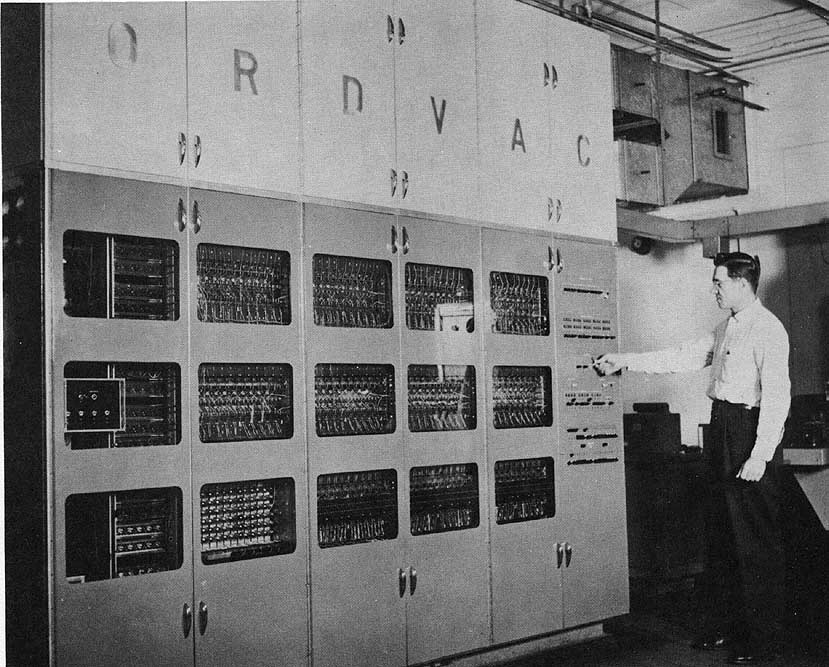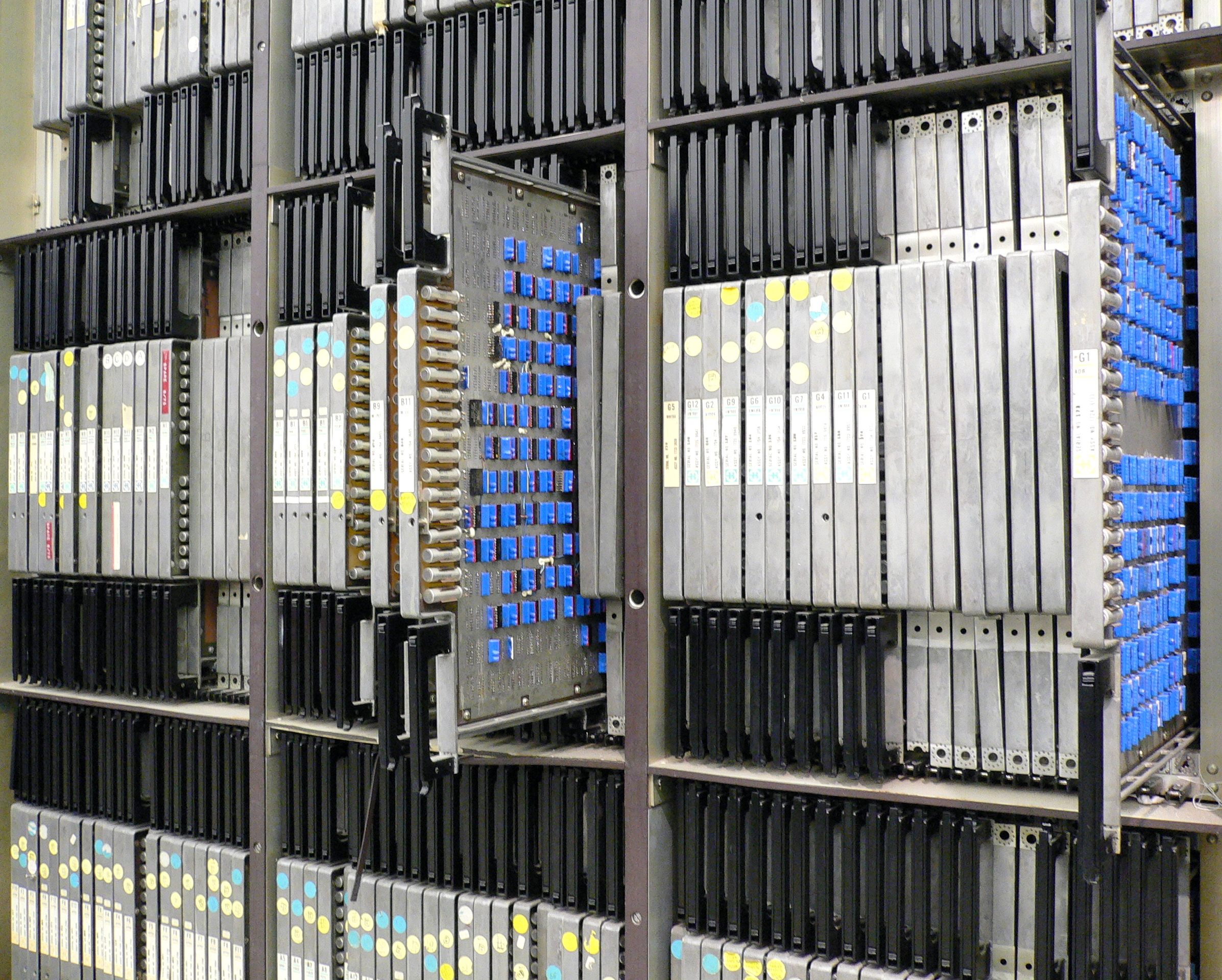|
ILLIAC III
The ILLIAC III was a fine-grained SIMD pattern recognition computer built by the University of Illinois in 1966. This ILLIAC's initial task was image processing of bubble chamber experiments used to detect nuclear particles. Later it was used on biological images. The machine was destroyed in a fire, caused by a Variac shorting on one of the wooden-top benches, in 1968. It was rebuilt in the early 1970s, and the core parallel-processing element of the machine, the Pattern Articulation Unit, was successfully implemented. In spite of this and the productive exploration of other advanced concepts, such as multiple-radix arithmetic, the project was eventually abandoned. Bruce H. McCormick was the leader of the project throughout its history. File:ILLIAC III IMG 4178.jpg File:ILLIAC III IMG 4177.jpg, Printed circuits of the type used in ILLIAC III File:ILLIAC III IMG 4176.jpg, Printed circuits of the type used in ILLIAC III See also * ORDVAC * ILLIAC I * ILLIAC II * ILLIAC IV The ... [...More Info...] [...Related Items...] OR: [Wikipedia] [Google] [Baidu] |
SIMD
Single instruction, multiple data (SIMD) is a type of parallel processing in Flynn's taxonomy. SIMD can be internal (part of the hardware design) and it can be directly accessible through an instruction set architecture (ISA), but it should not be confused with an ISA. SIMD describes computers with multiple processing elements that perform the same operation on multiple data points simultaneously. Such machines exploit data level parallelism, but not concurrency: there are simultaneous (parallel) computations, but each unit performs the exact same instruction at any given moment (just with different data). SIMD is particularly applicable to common tasks such as adjusting the contrast in a digital image or adjusting the volume of digital audio. Most modern CPU designs include SIMD instructions to improve the performance of multimedia use. SIMD has three different subcategories in Flynn's 1972 Taxonomy, one of which is SIMT. SIMT should not be confused with software thr ... [...More Info...] [...Related Items...] OR: [Wikipedia] [Google] [Baidu] |
Pattern Recognition
Pattern recognition is the automated recognition of patterns and regularities in data. It has applications in statistical data analysis, signal processing, image analysis, information retrieval, bioinformatics, data compression, computer graphics and machine learning. Pattern recognition has its origins in statistics and engineering; some modern approaches to pattern recognition include the use of machine learning, due to the increased availability of big data and a new abundance of processing power. These activities can be viewed as two facets of the same field of application, and they have undergone substantial development over the past few decades. Pattern recognition systems are commonly trained from labeled "training" data. When no labeled data are available, other algorithms can be used to discover previously unknown patterns. KDD and data mining have a larger focus on unsupervised methods and stronger connection to business use. Pattern recognition focuses more on the s ... [...More Info...] [...Related Items...] OR: [Wikipedia] [Google] [Baidu] |
University Of Illinois At Urbana–Champaign
The University of Illinois Urbana-Champaign (U of I, Illinois, University of Illinois, or UIUC) is a public land-grant research university in Illinois in the twin cities of Champaign and Urbana. It is the flagship institution of the University of Illinois system and was founded in 1867. Enrolling over 56,000 undergraduate and graduate students, the University of Illinois is one of the largest public universities by enrollment in the country. The University of Illinois Urbana-Champaign is a member of the Association of American Universities and is classified among "R1: Doctoral Universities – Very high research activity". In fiscal year 2019, research expenditures at Illinois totaled $652 million. The campus library system possesses the second-largest university library in the United States by holdings after Harvard University. The university also hosts the National Center for Supercomputing Applications and is home to the fastest supercomputer on a university campus. The ... [...More Info...] [...Related Items...] OR: [Wikipedia] [Google] [Baidu] |
Variac
An autotransformer is an electrical transformer with only one winding. The "auto" (Greek for "self") prefix refers to the single coil acting alone, not to any kind of automatic mechanism. In an autotransformer, portions of the same winding act as both the primary winding and secondary winding sides of the transformer. In contrast, an ordinary transformer has separate primary and secondary windings which have no metallic conducting path between them. The autotransformer winding has at least three taps where electrical connections are made. Since part of the winding does "double duty", autotransformers have the advantages of often being smaller, lighter, and cheaper than typical dual-winding transformers, but the disadvantage of not providing electrical isolation between primary and secondary circuits. Other advantages of autotransformers include lower leakage reactance, lower losses, lower excitation current, and increased VA rating for a given size and mass. An example of an a ... [...More Info...] [...Related Items...] OR: [Wikipedia] [Google] [Baidu] |
Bruce H
The English language name Bruce arrived in Scotland with the Normans, from the place name Brix, Manche in Normandy, France, meaning "the willowlands". Initially promulgated via the descendants of king Robert the Bruce (1274−1329), it has been a Scottish surname since medieval times; it is now a common given name. The variant ''Lebrix'' and ''Le Brix'' are French variations of the surname. Actors * Bruce Bennett (1906–2007), American actor and athlete * Bruce Boxleitner (born 1950), American actor * Bruce Campbell (born 1958), American actor, director, writer, producer and author * Bruce Davison (born 1946), American actor and director * Bruce Dern (born 1936), American actor * Bruce Gray (1936–2017), American-Canadian actor * Bruce Greenwood (born 1956), Canadian actor and musician * Bruce Herbelin-Earle (born 1998), English-French actor and model * Bruce Jones (born 1953), English actor * Bruce Kirby (1925–2021), American actor * Bruce Lee (1940–1973), martial art ... [...More Info...] [...Related Items...] OR: [Wikipedia] [Google] [Baidu] |
ORDVAC
The ORDVAC (''Ordnance Discrete Variable Automatic Computer)'', is an early computer built by the University of Illinois for the Ballistic Research Laboratory at Aberdeen Proving Ground. A successor to the ENIAC (along with EDVAC built earlier). It was based on the IAS architecture developed by John von Neumann, which came to be known as the von Neumann architecture. The ORDVAC was the first computer to have a compiler. ORDVAC passed its acceptance tests on March 6, 1952, at Aberdeen Proving Ground in Maryland. Its purpose was to perform ballistic trajectory calculations for the US Military. In 1992, the Ballistic Research Laboratory became a part of the U.S. Army Research Laboratory. Unlike the other computers of its era, the ORDVAC and ILLIAC I were twins and could exchange programs with each other. The later SILLIAC computer was a copy of the ORDVAC/ILLIAC series. J. P. Nash of the University of Illinois was a developer of both the ORDVAC and of the university's own identical ... [...More Info...] [...Related Items...] OR: [Wikipedia] [Google] [Baidu] |
ILLIAC I
The ILLIAC I (Illinois Automatic Computer), a pioneering computer in the ILLIAC series of computers built in 1952 by the University of Illinois, was the first computer built and owned entirely by a United States educational institution. Computer The project was the brainchild of Ralph Meagher and Abraham H. Taub, who both were associated with Princeton's Institute for Advanced Study before coming to the University of Illinois. The ILLIAC I became operational on September 1, 1952. It was the second of two identical computers, the first of which was ORDVAC, also built at the University of Illinois. These two machines were the first pair of machines to run the same instruction set. ILLIAC I was based on the IAS machine Von Neumann architecture as described by mathematician John von Neumann in his influential ''First Draft of a Report on the EDVAC''. Unlike most computers of its era, the ILLIAC I and ORDVAC computers were twin copies of the same design, with software compatibility. ... [...More Info...] [...Related Items...] OR: [Wikipedia] [Google] [Baidu] |
ILLIAC II
The ILLIAC II was a revolutionary super-computer built by the University of Illinois that became operational in 1962. Description The concept, proposed in 1958, pioneered Emitter-coupled logic (ECL) circuitry, pipelining, and transistor memory with a design goal of 100x speedup compared to ILLIAC I. ILLIAC II had 8192 words of core memory, backed up by 65,536 words of storage on magnetic drums. The core memory access time was 1.8 to 2 µs. The magnetic drum access time was 8.5ms. A "fast buffer" was also provided for storage of short loops and intermediate results (similar in concept to what is now called cache). The "fast buffer" access time was 0.25 µs. The word size was 52 bits. Floating point numbers used a format with 7 bits of exponent (power of 4) and 45 bits of mantissa. Instructions were either 26 bits or 13 bits long, allowing packing of up to 4 instructions per memory word. Rather than naming the pipeline stages, "Fetch, Decode, and Execute" (as on Stretch), t ... [...More Info...] [...Related Items...] OR: [Wikipedia] [Google] [Baidu] |
ILLIAC IV
The ILLIAC IV was the first massively parallel computer. The system was originally designed to have 256 64-bit floating point units (FPUs) and four central processing units (CPUs) able to process 1 billion operations per second. Due to budget constraints, only a single "quadrant" with 64 FPUs and a single CPU was built. Since the FPUs all had to process the same instruction – ADD, SUB etc. – in modern terminology the design would be considered to be single instruction, multiple data, or SIMD. The concept of building a computer using an array of processors came to Daniel Slotnick while working as a programmer on the IAS machine in 1952. A formal design did not start until 1960, when Slotnick was working at Westinghouse Electric and arranged development funding under a US Air Force contract. When that funding ended in 1964, Slotnick moved to the University of Illinois and joined the Illinois Automatic Computer (ILLIAC) team. With funding from Advanced Research Projects Agency ( ... [...More Info...] [...Related Items...] OR: [Wikipedia] [Google] [Baidu] |
One-of-a-kind Computers
One of a Kind may refer to: Film and television * ''One of a Kind'' (film), a 2013 French film * ''One of a Kind'' (game show), a 1958–1959 Canadian panel show * ''One of a Kind'' (TV series), a 1978 Canadian children's series * "One of a Kind" (''Brandy & Mr. Whiskers''), a television episode * "One of a Kind" (''Danny Phantom''), a television episode Music Albums * ''One of a Kind'' (Bruford album) or the title song, 1979 * ''One of a Kind'' (Dave Grusin album), 1977 * ''One of a Kind'' (Moe Bandy album) or the title song, 1979 * ''One of a Kind'' (Pandora album) or the title song (see below), 1993 * ''One of a Kind'' (Tammy Wynette album) or the title song (see below), 1977 * ''One of a Kind'' (G-Dragon EP) or the title song (see below), 2012 * ''One of a Kind'' (Monsta X EP), 2021 * ''One of a Kind'', by Della Reese, 1978 * ''One of a Kind'', by Orleans, or the title song, 1982 Songs * "One of a Kind" (G-Dragon song), 2012 * "One of a Kind" (Pandora song), 19 ... [...More Info...] [...Related Items...] OR: [Wikipedia] [Google] [Baidu] |





